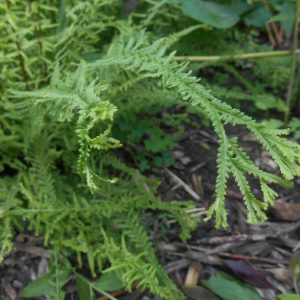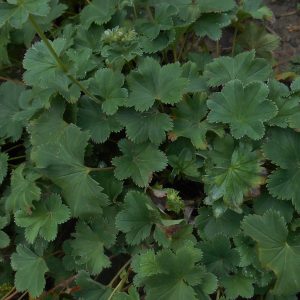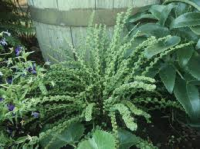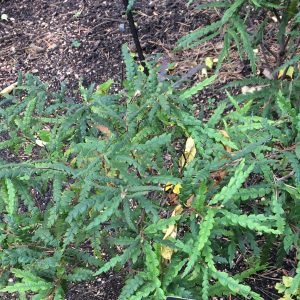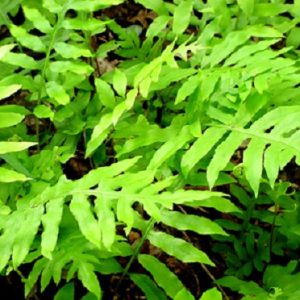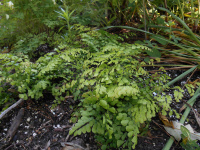…macedonica Korean maple Acer pseudosieboldianum Ladybells Adenophora lilifolia Lady fern Athyrium filix-femina Lady’s mantle Alchemilla mollis Lamb’s ears, Betony Stachys byzantia Lanceleaf hosta Hosta lancifolia Larkspur Delphinium elatum Lavender…
More »Search Results for: Lady fern
-
Athyrium filix femina ‘Victoriae’ Victoria lady fern Z 4-8
OUT OF STOCK Clumping fern with finely divided fronds have tiny, twisted leaflets that cross one another. Vigorous grower. Dr, John Mickel, former curator of ferns at the New York...
OUT OF STOCK
Clumping fern with finely divided fronds have tiny, twisted leaflets that cross one another. Vigorous grower. Dr, John Mickel, former curator of ferns at the New York Botanical Garden, called this “the Queen of green.”
Size: 18-24” x 18-24”
Care: part to full shade in moist to moist well-drained soilPopular Victorian fern. Mutation of Lady Fern discovered in Scotland in 1861.
-
Athyrium filix-femina Lady fern Z 3-8
Clumping fern with lance-shaped, double compound fronds – leaflets upon the midrib usually opposite one another, 1-2’ long and 5-12” wide and tapered to a point at the tip. One...
Clumping fern with lance-shaped, double compound fronds – leaflets upon the midrib usually opposite one another, 1-2’ long and 5-12” wide and tapered to a point at the tip. One of the easiest ferns to grow.
Size: 4’ x 2-4’
Care: moist to well-drained soil in full to part shade
Native: temperate No. America including Wisconsin
Awards: England’s Royal Horticultural Society Award of Merit.Chippewa made a decoction of the root for it diuretic. Meskwaki made a decoction from the roots to relieve breast pain after childbirth. For Ojibwa and Potawatomi it brought on milk flow in nursing mothers with caked breast. Ojibwa also dried and grated roots to heal sores. Quileute wiped fish with the leaves and ate roasted, peeled root.
First described for botany, but given a different name, by English botanist Leonard Plukenet (1641-1706) in 1692.
Laugh at Walnut Trees
…all (and those formerly called Aster that taxonomists gave long names) Astilbe – all Athyrium filix-femina Lady fern Betula nigra River birch Bouteloua gracilis Blue gramma Campanula – all Carex…
More »-
Alchemilla erythropoda Dwarf lady’s mantle Z 3-7
OUT OF STOCK A miniature Lady’s Mantle for edging borders or growing in the rock garden. Short sprays of chartreuse flowers appear over a dense mound of scalloped light-green leaves...
OUT OF STOCK
A miniature Lady’s Mantle for edging borders or growing in the rock garden. Short sprays of chartreuse flowers appear over a dense mound of scalloped light-green leaves that catch and hold rain or dewdrops
Size: 6-10” x 9-12”
Care: Sun to shade in moist well-drained soil
Native: Eastern Europe
Awards: Royal Horticultural Society Award of MeritDescribed in Flora Kavkaza Flora Kavkaza in 1928.
-
Athyrium filix-femina ‘Frizelliae’ Tatting fern Z 4-8
OUT OF STOCK Clumping fern bearing unusual fronds – button-like along the midrib...
OUT OF STOCK
Clumping fern bearing unusual fronds – button-like along the midrib
Size: 18” x 18”
Care: Moist humusy soil in part sun to part shade
Awards: Great Plant Pick Award from Elizabeth Carey Miller Botanical Garden.Short genetic mutation of Lady Fern discovered in 1857 in Mrs. Frizelle’s garden in Ireland.
-
Comptonia peregrina Sweet Fern Z 2-6 SHRUB
Grown for its fern like leaves, this small shrub flowers in spring with insignificant yellow flowers followed by brown nutlets. Foliage is fragrant when crushed. LIMITED QUANTITES AVAILABLE. ONE PER...
Grown for its fern like leaves, this small shrub flowers in spring with insignificant yellow flowers followed by brown nutlets. Foliage is fragrant when crushed.
LIMITED QUANTITES AVAILABLE. ONE PER CUSTOMER PLEASE.
Size: 2-5’ x 4’ spreading
Care: sun to part shade in moist, well-drained to well-drained soil. Prefers acidic, but will grow in other types of soil as well. Drought and salt tolerant.
Native: Eastern North America, Wisconsin native
Wildlife Value: Attracts bees, butterflies, & birds. Larval host plant for many moths, including Io moth, several Sphinx moth species, and the Anise Swallowtail butterfly. Deer resistant. Nitrogen fixer.Genus name honors Henry Compton (1632-1713), Bishop of London and patron of botany. Many Native Americans (Algonquin, Cherokee, Chippewa, Delaware, Menominee, Potawatomi) used this plant for a wide variety of purposes: crushed leaves inhaled for headache. Leaf infusions for round worms, fevers, beverage, blood purifier, blisters, clear mucus from lungs, bladder inflammation, rash from poison ivy, swelling, flux, stomach cramps, itch. Fragrant leaves- burned or crushed for incense in ceremony, perfume; decoction for childbirth, tonic. Other: sprinkle on medicine to poison enemy, prevent blueberries from spoiling, leaves in fire to make smudge to ward off mosquitoes. Oneida made a tea.
Collected for botany before 1753. Grown at America’s 1st botanic garden, Elgin Botanic Garden 1811.**LISTED AS OUT OF STOCK BECAUSE WE DO NOT SHIP THIS ITEM. IT IS AVAILABLE FOR PURCHASE AT OUR RETAIL LOCATION.
-
Dryopteris filix-mas ‘Parsley’ Male fern Z 4-8
...not currently for sale. This is an archive page preserved for informational use. Spring fiddleheads are followed by crinkled ferny leaves resembling parsley on arching stems on this small fern....
ARCHIVED
Note: This is a plant not currently for sale. This is an archive page preserved for informational use.
Spring fiddleheads are followed by crinkled ferny leaves resembling parsley on arching stems on this small fern.
Size: 2’ x 2’
Care: shade to part sun in moist well-drained soil, tolerates clay
Native: Europe and North America
Wildlife Value: provides shelter and habitat for birds and bees, Deer & rabbit ResistantDryopteris filix-mas collected before 1834, Victorian cultivar.
-
Onoclea sensibilis Sensitive fern Zones 4-10
...then grow outward with lance-shaped fronds with wavy leaf margins. Don’t be fooled by the name sensitive. This is a tough fern growing just about any place with some shade....
Medium green fronds grow with deep curves along the wide stem then grow outward with lance-shaped fronds with wavy leaf margins. Don’t be fooled by the name sensitive. This is a tough fern growing just about any place with some shade.
Size: 12-20" x 24” spreading, slowly by rhizomes.
Care: part to full shade in moist to well-drained soil
Native: Eastern North America, Wisconsin native
Awards: England’s Royal Horticultural Society Award of Merit.Collected before 1700. Sensibilis means sensitive on account of fronds dying back when it frosts. Oneida used this for bedding when hunting. According to Oneida tradition if a woman drinks an infusion, she can never have children after she gets married.
-
Adiantum venustum Himalayan maidenhair fern Z 5-8
OUT OF STOCK Black stems hold triangular, delicate, lacy fronds of tiny leaflets. Favorite short fern....
OUT OF STOCK
Black stems hold triangular, delicate, lacy fronds of tiny leaflets. Favorite short fern.
Size: 6" x 12", slow spreader
Care: part or light shade in moist well-drained soil but tolerates any soil
Native: China and Himalayan Mountains
Awards: Great Plant Pick from Elisabeth Cary Miller Botanic Garden & Royal Horticultural Society Award of Garden MeritAdiantum is from Greek adiantos, “unwettable” because its fronds repel water. Venustum means attractive in Latin. (We think it should be “venustumest” for most attractive.) Collected for gardens by 1841.

